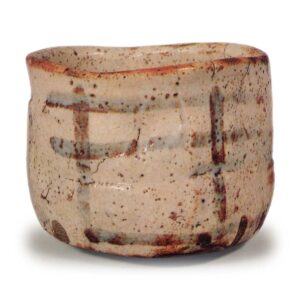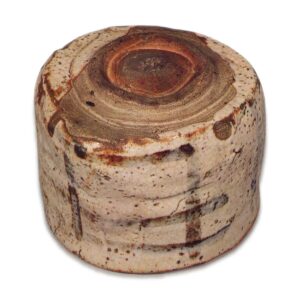

National Treasure
Height 9.5cm, Bowl diameter 11.8cm, Stand diameter 6.0cm
This is said to be the first masterpiece among Shino tea bowls. The unparalleled skill and depth of flavor of this tea bowl, which is shaped in a wheel-thrown, hand-kneaded style, is equally recognized by those who have been curious about Shino. The thickness of the entire body and the weight of the handles are in proportion to the size of the bowl. Since the body is almost triangularly distorted, there are quite different tastes depending on the side you look at, and it is impossible to know the entirety of the tea bowl from just one side. The gently sloping mouth structure in the shape of a mountain road, the deep and wide prospect, and the slightly lowered high stand are powerfully carved out of the interior with wood. The craftsmanship of the high stand is outstanding among the many Japanese tea bowls I have held in my hands, and the shallow step on the side of the stand is also unparalleled.
The tranquil Yotsumegaki-style painting on the body is slightly lighter under the glaze, and the Hyakuso clay (so called because of its similarity to Hyakuso) seen around the base has been moderately tightened to give a deep flavor, while the inside of the base has been mildly burnt red. The white glaze has a faint reddish tinge, and the fire color at the mouth rim is particularly vivid. There are three finger marks on the rim, and an orifice mark in the center of the base, indicating that it was fired in a potter’s wheel. It is believed to have been fired in the Muta-do kiln in Ohgaya.
The waka poem “Yamasato no unohagaki no nakatsu michi yuki fumiwake shiko chikosurre” (poem by Ishu Katagiri), which is pasted on the back of the lid, is said to have been written by Ishu.
Originally belonging to the Fuyuki family, a wealthy merchant in Edo, it was given to Kinnosuke Yamada of Osaka at the beginning of the Meiji era (1868-1912), and in 1890, it became part of the Muromachi Mitsui family’s collection. It was designated a national treasure in 1959.
Unohanagaki
A national treasure. A national treasure. Kokyaki tea bowl, Shino. With a box and inscription by Katagiri Ishu, the front has the inscription “Unohagaki” and the back has the inscription “The road inside the mountain village of Unohana is a place where one can step on the snow. It is said that the artist chose this poem inscription because of the roughly woven black streaks in the snowy white glaze. Originally owned by the Fuyuki family of Edo, it came into the possession of a certain Yamada in the early Meiji period. In the Kansai region, this tea bowl and the Hagoromo and Yamazato tea bowls are highly praised as the best of all Shino tea bowls, and it is said that the first tea bowl sold for 1,000 yen around 1890 (Meiji 23) was the Ubana-gamen. (Taisho Meikikan)


